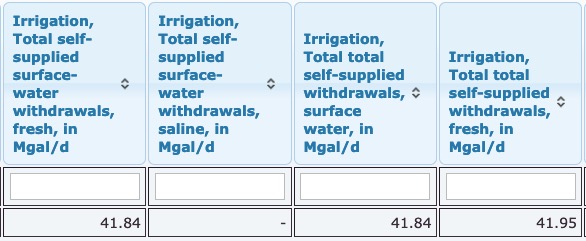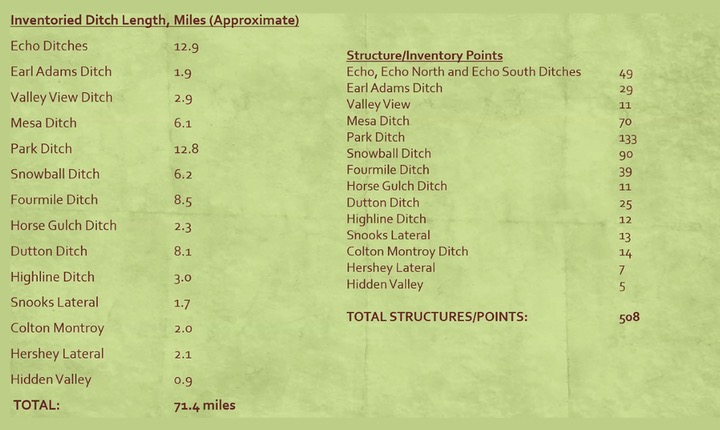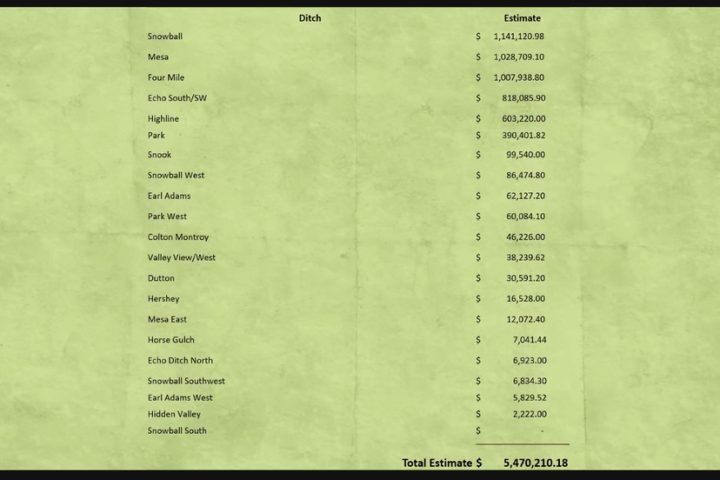As was mentioned earlier in the editorial series, the Upper San Juan Water Enhancement Partnership (WEP) — in collaboration with Durango-based Mountain Studies Institute — hosting a public Zoom presentation summarizing “Phase II” of a three-phase project: the creation of a ‘Stream Management Plan” for the eastern half of Archuleta County. The work is being funded by various government agencies.
Rivers included in the project include the upper San Juan River — north of downtown Pagosa Springs — and its tributaries, as well as the Blanco River and the Navajo River.
A sizable share of the water from the Blanco and Navajo rivers gets diverted by the San Juan-Chama Project. About 110,000 acre-feet per year are sent into New Mexico, with about half of that water going to service the City of Albuquerque.
Some of the Blanco and Navajo water gets used for agricultural irrigation here in Archuleta County; I don’t have any data for what amount. Whatever is left over, flows downstream to wind up in the 1.7 million-acre-foot Navajo Reservoir.
The upper San Juan River and its tributaries, meanwhile, play a major role in the municipal water picture here in Pagosa Springs, but play an even larger role in the agricultural industry within the San Juan River watershed.
Note: I currently serve on the San Juan Water Conservancy District board of directors, but this editorial reflects only my personal perspectives and opinions, and not necessarily the perspectives or opinions of anyone else on the SJWCD Board. SJWCD has been helping to fund WEP research.
On Friday, we looked briefly at the WEP presentation from San Juan Conservation District Manager Cynthia Purcell. Ms. Purcell and her team of researchers walked about 71 miles of agricultural ditches and documented — with photographs, measurements and commentary — about 500 diversion structures and other inventory details.
To some Daily Post readers, this may sound like a minor achievement, but I find myself impressed by the effort. I’ve been covering water policy issues here in Archuleta County for about 16 years, and I’ve never heard of this type of inventory being carried out. Hopefully, it marks the beginning of improved data collection, in our community, on the agricultural side of the water-diversion equation.
During her presentation, Ms. Purcell shared an (anonymous) sample of the type of data her team collected. In this case, she was discussing a particular ‘diversion box’ that had been analyzed, and photographed from several angles. She discussed the fact that this older piece of infrastructure could benefit from repair or replacement, and that a replacement might cost in the neighborhood of $23,000.
(The Power Point slide says “Division Box” but perhaps it’s actually a “Diversion Box”?)
After documenting 500 diversion details on 71 miles of irrigation ditches, Ms. Purcell and her team came up with a laundry list of suggested improvements that would make the old ditch systems function more efficiently, and use less water. The improvement were of two basic types.
First, improvements to the ditch systems, and secondly, improvements to the type of irrigation systems used.
The ditch improvements and repairs suggested by the WEP survey appear to total nearly $5.5 million.
As was mentioned on Friday, nearly all of the ranches in Archuleta County are still using a type of irrigation that dates back to the 19th century: ditch irrigation. This style of crop watering is only about 30%-50% efficient — suggesting that 50%-70% of the water diverted is not benefiting the irrigated crop.
Only a few of the ranches are using ‘gated pipe’. Gated pipe is supposedly 50%-60% efficient.
Almost none of the local ranches inventoried are using ‘sprinkler irrigation’, even though that system makes the most efficient use of our precious water resources… with 70%-75% efficiency.
Ms. Purcell’s team then calculated what it might cost to improve the irrigation systems on some of our local ranches.
$3.3 million for irrigation systems?
Plus $5.5. million for ditch improvements and repairs?
Ms. Purcell did not give us an estimate of what $8.8 million worth of improvements might mean for “enhancing” total water diversions in Archuleta County. To define that impact, we would need to know approximately how much water our local ranches are using currently. For that, we can look at some numbers provided by the US Geological Survey.
According to USGS data for Archuleta County, about 8,590 people were served by “public” water supplies in 2015, using about 2.44 million gallons per day, which comes to about 890 million gallons used that year. (This number comes from the ‘Public Supply’ table of data on the USGS website.)
Other uses of water tracked by USGS include mining, industrial, livestock, and of course, agricultural. Mining, commercial industry, and livestock watering use relatively minor amounts of local water.
Under the “Irrigation” tab, we can find the amount of water that USGS believes was used for irrigation purposes in Archuleta County, in 2015.

41.95 million gallon per day, on average. About 15.3 billion gallons per year. 47,000 acre-feet per year. About the same amount of water used annually by the entire City of Albuquerque.
It would appear from the USGS numbers that “irrigation” accounts for about 94 percent of all water used in Archuleta County. If ‘water conservation’ is a meaningful goal, then we obviously need to look to agriculture for meaningful solutions. And Ms. Purcell’s team appears to be starting the process of defining how much such conservation efforts might cost.
$8.8 million. As a rough estimate.
If agricultural users paid for water the way commercial and residential users do, the diversion numbers might look very different. But what commercial and residential users are paying for is ‘water treatment and delivery.’ Ordinary citizens pay for ‘drinking water’… clean drinking water, delivered to the tap. Agricultural users in Archuleta County do not need their water to be treated by a water district; they use ‘raw water’. They also maintain, on their own dime, the various ditches and pipes that deliver raw water to their ranches and farms.
In other words, water is free, to agricultural users… if you don’t count the effort to build and maintain the diversion structures.
This Pagosa Springs industry reportedly accounts for 94 percent of total water diverted from rivers, creeks and streams. It does not, however, provide 94 percent of the community’s overall economic activity. According to the US Department of Agriculture, the total net income from farming and ranching in Archuleta County in 2017 was -$2.1 million. That’s negative $2.1 million, net income, resulting from about $11.2 million in agricultural sales. An average loss of $5,291 per farm.
According to USDA, 68 percent of our local farms and ranches sold less than $10,000 in products. The industry that uses 94 percent of the community’s water, loses money doing it.
Where would $8.8 million come from, to help Archuleta County ranches make more efficient use of our limited water?




